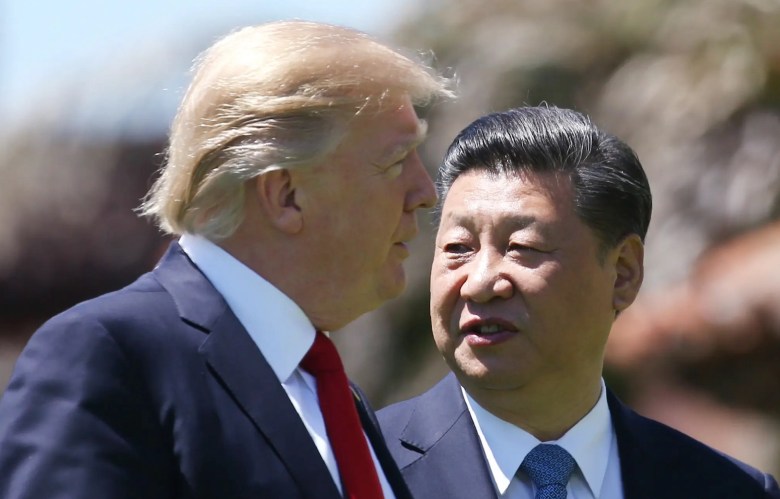Politics
US-China Relations Shift as Trump Considers Asian Withdrawal

Tensions are rising in Asia as speculation grows over a potential shift in United States foreign policy. Following a phone call between US President Donald Trump and Chinese President Xi Jinping, both leaders described the conversation as positive. This comes ahead of a scheduled bilateral meeting in October 2023, where significant developments are anticipated. Reports suggest that the US might be considering a partial withdrawal from Asia, allowing China to expand its political and strategic influence in the region.
In an interview with Marco Mayer from Starmag, Francesco Sisci of the Appia Institute discussed the implications of this potential policy shift. Mayer posed a crucial question regarding whether the US is indeed working towards establishing two major spheres of influence, with the US focusing on the Americas while China strengthens its position in Asia. Sisci expressed skepticism about such an agreement, warning that a partial US withdrawal could have destabilizing effects.
“Asian countries don’t want to be ‘sold out’ by America to China,” Sisci explained. He emphasized that even a limited US pullback would likely escalate tensions both regionally and globally.
The geopolitical landscape is particularly complex, especially concerning relationships among countries like Pakistan, China, and Saudi Arabia, contrasted with India, the Philippines, and Japan. Sisci pointed out the fragile nature of these dynamics, especially as Pakistan and Saudi Arabia recently signed a defense agreement aimed at addressing threats in Yemen. This agreement could inadvertently lead to stronger ties between India and Iran if not managed carefully.
As the Philippines navigates its alliances, it has recently tilted towards China, which may encourage similar pacts among Vietnam, Indonesia, and Japan. Despite some countries potentially aligning with Beijing, Sisci believes there will be significant resistance against China across the region.
Russia’s Role and Regional Military Dynamics
Sisci also examined Russia’s influence in Asia, contrasting it with the dynamics in Europe. He noted that while European countries have reduced military spending, believing the Russian threat was diminished, Asian nations have remained vigilant. “No Asian country ever saw Beijing as non-threatening,” he stated, underscoring the continuous military readiness of these nations, which has recently escalated due to rising tensions stemming from both Chinese and Russian military activities.
As countries like South Korea and Japan explore nuclear capabilities, Sisci cautioned that a major bilateral agreement between the US and China could ignite a nuclear arms race in Asia. He asserted that such developments would lead to dire consequences, potentially creating a precarious situation reminiscent of the Cold War.
“If South Korea and Japan were to acquire nuclear weapons, other nations like Vietnam and Thailand might follow suit,” Sisci warned. “The overall tense situation could lead to an apocalyptic scenario.”
Mayer queried whether the India-China rapprochement could be attributed solely to US tariffs. Sisci suggested that underlying tensions, particularly concerning the India-Pakistan relationship, complicate this dynamic. He noted that historical grievances and contemporary experiences contribute to the reluctance of neighboring countries to solidify ties with China.
The Future of Asian Alliances
Despite deepening trade ties with China, many Asian nations view Beijing with skepticism. Sisci explained that China’s historical actions and economic strategies have fostered fear among its neighbors. While some countries have moved closer to China due to US tariffs, a US withdrawal from the region could catalyze new conflicts.
Sisci further elaborated on the military developments in Asia, stating that the region is now witnessing an arms race driven by fears of Chinese expansionism. “Japan, Vietnam, and India are forming intelligence-sharing networks that could act as a deterrent against China,” he noted. This partnership, known as the Quad, aims to counterbalance Chinese influence without direct US involvement.
The absence of multilateral organizations in Asia, unlike NATO in Europe, creates a more flexible diplomatic environment. Countries can pursue their defense policies with fewer constraints, which could lead to a broader arms buildup. Sisci argued that a comprehensive agreement with China would require multilateral cooperation, engaging all affected Asian nations.
“Even with all its complexity, this dialogue remains easier than slipping into an arms race in Asia without the United States,” he concluded.
As the US and China navigate their evolving relationship, the implications for regional stability and global security are profound. The potential for a partial US withdrawal from Asia raises questions not only about the future of US-China relations but also about the broader geopolitical landscape in an increasingly multipolar world.
-

 Business5 months ago
Business5 months agoKenvue Dismisses CEO Thibaut Mongon as Strategic Review Advances
-

 Lifestyle4 months ago
Lifestyle4 months agoHumanism Camp Engages 250 Youths in Summer Fest 2025
-

 Sports4 months ago
Sports4 months agoDe Minaur Triumphs at Washington Open After Thrilling Comeback
-

 Sports5 months ago
Sports5 months agoTupou and Daugunu Join First Nations Squad for Lions Clash
-

 Top Stories5 months ago
Top Stories5 months agoColombian Senator Miguel Uribe Shows Signs of Recovery After Attack
-

 World5 months ago
World5 months agoASEAN Gears Up for Historic Joint Meeting of Foreign and Economic Ministers
-

 Health4 months ago
Health4 months agoNew Study Challenges Assumptions About Aging and Inflammation
-

 Business5 months ago
Business5 months agoOil Prices Surge Following New EU Sanctions on Russia
-

 Entertainment4 months ago
Entertainment4 months agoDetaşe-Sabah Violin Ensemble Captivates at Gabala Music Festival
-

 Entertainment4 months ago
Entertainment4 months agoBaku Metro Extends Hours for Justin Timberlake Concert
-

 Top Stories5 months ago
Top Stories5 months agoRethinking Singapore’s F&B Regulations Amid Business Closures
-

 Business5 months ago
Business5 months agoU.S. House Approves Stablecoin Bill, Sends to Trump for Signature









